- New Taiwan dollar
-
TWD redirects here. For other uses, please see: TWD (disambiguation)
New Taiwan dollar 新臺幣 / 新台幣 (Chinese) 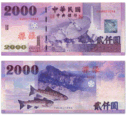

NT$2000 NT$50 ISO 4217 code TWD User(s)  Republic of China (Taiwan)
Republic of China (Taiwan)Inflation 2.34%,3.7% (CIA World Factbook, 2008 est.) Source Central Bank of the Republic of China, Jul-Dec 2007 Method CPI Subunit 1/10 角
Jiao, but no official translation1/100 cent (分, Fen)
Subunits used only in stocks and currenciesSymbol $ or NT$ Nickname kuài (塊) 角 máo (毛) Plural dollars (English only) cent (分, Fen) cents (English only) Coins Freq. used $1, $5, $10, $50 Rarely used $20 Banknotes Freq. used $100, $500, $1000 Rarely used $200, $2000 Central bank Central Bank of the Republic of China Website www.cbc.gov.tw Printer China Engraving and Printing Works Website www.cepp.gov.tw Mint Central Mint of China Website www.cmc.gov.tw New Taiwan dollar 
A NT$100 note issued by Bank of Taiwan in February 1988. It was taken out of circulation on July 1, 2002, as it had been replaced by a new NT$100 note on July 2, 2001 issued by the Central Bank of the Republic of China. Traditional Chinese 新臺幣 or 新台幣 Simplified Chinese 新台币 Transcriptions Mandarin - Hanyu Pinyin Xīntáibì - Tongyong Pinyin Sīntáibì - Wade–Giles Hsint'aipi Min - Hokkien POJ Sin-tâi-pè Cantonese (Yue) - Jyutping Santoibai - Yale Romanization Syin1tai2bi4 The New Taiwan dollar (traditional Chinese: 新臺幣 or 新台幣; simplified Chinese: 新台币; Tongyong Pinyin: Sīntáibì; Hanyu Pinyin: Xīntáibì) (currency code TWD and common abbreviation NT$), or simply Taiwan dollar, is the official currency of the Taiwan Area of the Republic of China (ROC) since 1949, when it replaced the Old Taiwan dollar. Originally issued by the Bank of Taiwan, it has been issued by the Central Bank of the Republic of China since 2000.
Contents
Etymology
The Chinese term for "New Taiwan Dollar" (新臺幣 or 新台幣, literally "New Taiwan Currency") typically is only used for banking and in legal contracts where it is necessary to avoid any possible ambiguity, or when talking about foreign exchange or other currencies.
In common usage, the dollar unit is typically referred to as yuán. In Taiwan, the character for yuán can be written in either of two forms, an informal 元 or a formal 圓, both of which are interchangeable. Mandarin speakers also use kuài. Kuài is written 塊 and is an abbreviation for 塊錢 (kuài qián), which literally means "piece of money". In the context of discussing prices, 錢 can be omitted. In general, yuán is more commonly used when writing and kuài is more commonly used when speaking.
Taiwanese speakers may also use the word kho͘ (箍 ; literally "circle").
In English usage the New Taiwan Dollar is often abbreviated as NT, NT$, NT Dollar or NTD, while the abbreviation TWD is typically used in the context of foreign exchange rates. Subdivisions of a New Taiwan Dollar are rarely used, since practically all products on the consumer market are being sold at whole dollars.
History
The New Taiwan dollar was first issued by the Bank of Taiwan on June 15, 1949, to replace the Old Taiwan dollar at a 40,000-to-1 ratio. The first goal of the New Taiwan dollar was to end the hyperinflation that had plagued Taiwan and Mainland China due to the Chinese civil war fought in mainland China. A few months later, the ROC government under the Kuomintang (KMT) was defeated by the Chinese communists and retreated to Taiwan.
Even though the Taiwan dollar was the de facto currency of Taiwan, for years the old Chinese Nationalist yuan was still the official national currency of the Republic of China. The Chinese Nationalist yuan was also known as the fiat currency (法幣) or the silver yuán (銀元), even though it was decoupled from the value of silver during World War II. Many older statutes in ROC law have fines and fees denominated in this currency.
According to the Regulation of exchange rate between New Taiwan Dollars and the fiat currency in the ROC laws (現行法規所定貨幣單位折算新臺幣條例), the exchange rate is fixed at 3 TWD per 1 silver yuan and has never been changed despite decades of inflation. Despite the silver yuan being the primary legal tender currency, it was impossible to buy, sell, or use it, so it effectively did not exist to the public.
In July 2000, the New Taiwan dollar became the official currency of the ROC and is no longer secondary to the silver yuan. At the same time, the Central Bank of China (now known as the Central Bank of the Republic of China) began issuing New Taiwan dollar banknotes directly and the old notes issued by the Bank of Taiwan were taken out of circulation.
In the history of the currency, the exchange rate as compared to the United States dollar (USD) has varied from less than 10 TWD per USD in the mid-1950s to more than 40 TWD per 1 USD in the 1960s and about 25 TWD per 1 USD around 1992. The exchange rate as of October 26, 2011 sits around 30.105 TWD per 1 USD.
Coins
The denominations of the Taiwan dollar in circulation are
Currently Circulating Coins Image Value Technical parameters Description Date of Diameter Weight Composition Obverse Reverse first minting issue 
NT$½ 18 mm 3 g 97 % copper
2.5% zinc
0.5% tinMei Blossom, "中華民國XX年"1 Value 1981
(Minguo year 70)December 8, 1981[1] 
NT$1 20 mm 3.8 g 92% copper
6% nickel
2% aluminiumChiang Kai-shek, "中華民國XX年" December 8, 1981[1] 
NT$5 22 mm 4.4 g Cupronickel
75% copper
25% nickelChiang Kai-shek, "中華民國XX年" Value 1981
(Minguo year 70)December 8, 1981[1] 
NT$10 26 mm 7.5 g December 8, 1981[1] 
NT$20 26.85 mm 8.5 g Ring: Aluminium bronze (as $50)
Center: Cupronickel (as $10)Mona Rudao, "莫那魯道"2, "中華民國XX年" Traditional canoes used by the Tao people 2001
(Minguo year 90)July 9, 2001[2] 
NT$50 28 mm 10 g Aluminium bronze
92% copper
6% aluminium
2% nickelSun Yat-sen, "中華民國XX年" Latent images of both Chinese and Arabic numerals for 50 2002
(Minguo year 91)April 26, 2002[3] These images are to scale at 2.5 pixels per millimeter. For table standards, see the coin specification table. Coins are minted by the Central Mint of China, while notes are printed by the China Engraving and Printing Works. Both are run by the Central Bank of the Republic of China. The NT$½ coin is rare because of its low value, while the NT$20 coin is rare because of the government's lack of willingness to promote it. As of 2010, the cost of the raw materials in a NT$½ coin is worth more than the face value of the coin.
Remarks
- "中華民國XX年" = "Minguo XX". "中華民國" is also the state title "Republic of China".
- "莫那魯道" = "Mona Rudao", anti-Japanese leader at the Wushe Incident.
Banknotes
The current series of banknotes for the New Taiwan Dollar began circulation in July 2000. This set was introduced when the New Taiwan Dollar succeeded the silver yuan as the official currency within the Republic of China.
The current set includes banknotes for NT$100, NT$200, NT$500, NT$1000, and NT$2000. Note that the NT$200 and NT$2000 banknotes are not commonly used by consumers. This may be due to the tendencies of consumers to simply use multiple NT$100 or NT$500 bills to cover the range of the NT$200, as well as using NT$1000 bills or credit/debit cards instead of the NT$2000 bill. Lack of government promotion may also be a contributing factor to the general lack of usage.
It is relatively easy for the government to disseminate these denominations through various government bodies that do official business with the citizens, such as the post office, the tax authority, or state owned banks. There is also a conspiracy theory against the Democratic Progressive Party, the ruling party at the time the two denominations were issued. The conspiracy states that putting Chiang Kai-shek on a rarely used banknote would "practically" remove him from the currency, while "nominally" including him on the currency would not upset supporters on the other side of the political spectrum that much (the Pan-Blue Coalition).
1999 Series Image Value Dimensions Main Color Description Date of Remark Obverse Reverse Watermark printing issue withdrawal 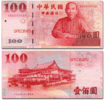
NT$100 145 × 70 mm Red Sun Yat-sen, "The Chapter of Great Harmony" by Confucius Chung-Shan Building Mei flower and numeral 100 2000
(Minguo 89)July 2, 2001 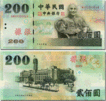
NT$200 150 × 70 mm Green Chiang Kai-shek, theme of land reform and public education The Office of the President Orchid and numeral 200 2001
(Minguo year 90)January 2, 2002 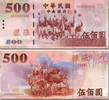
NT$500 155 × 70 mm Brown Youth baseball Formosan Sika Deer and Dabajian Mountain Bamboo and numeral 500 2000
(Minguo year 89)December 15, 2000 August 1, 2007 without holographic strip 
Dark brown 2004
(Minguo 93)July 20, 2005 with holographic strip 
NT$1000 160 × 70 mm Blue Elementary Education (errors[4][5]) Mikado Pheasant and Yushan (Jade Mountain) Chrysanthemum and numeral 1000 1999
(Minguo year 88)July 3, 2000 August 1, 2007 without holographic strip 
2004
(Minguo year 93)July 20, 2005 with holographic strip 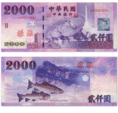
NT$2000 165 × 70 mm Purple FORMOSAT-1, technology Formosan landlocked salmon and Nanhu Mountain Pine and numeral 2000 2001
(Minguo year 90)July 1, 2002 These images are to scale at 0.7 pixels per millimeter. For table standards, see the banknote specification table. The year 2000 version $500 and 1999 version $1000 notes without holographic strip were officially taken out of circulation on August 1, 2007. They were redeemable at commercial banks until September 30, 2007. As of October 1, 2007, only the Bank of Taiwan accepts such notes.[6]
Taiwan 100-dollar commemorative note

On 6 January 2011, the Central Bank of the Republic of China issued a new 100-dollar legal tender circulating commemorative in celebration of the 100th anniversary of the founding of the Republic of China. The red paper note measures 145 × 70 mm and features a portrait of Dr. Sun Yat-Sen on the front, and the Chung-Shan Building on the back. The design is no different from the ordinary NT$100 note, except for the wording in Chinese language in the reverse of the note, which reads: “Celebrating the 100 years of founding of the Republic of China.”[7]Current TWD exchange rates From Google Finance: AUD CAD CHF EUR GBP HKD JPY USD CNY TRY From Yahoo! Finance: AUD CAD CHF EUR GBP HKD JPY USD CNY TRY From OzForex: AUD CAD CHF EUR GBP HKD JPY USD CNY TRY From XE.com: AUD CAD CHF EUR GBP HKD JPY USD CNY TRY From OANDA.com: AUD CAD CHF EUR GBP HKD JPY USD CNY TRY See also
- History of the Republic of China
- Economy of the Republic of China
References
- ^ a b c d http://www.cbc.gov.tw/issue/money/tb1.htm 中央銀行發行之貨幣及偵偽鈔辨識
- ^ "20元新硬幣亮相!" (in Chinese). 大紀元. 2001-07-05. http://www.epochtimes.com/b5/1/7/5/n106577.htm. Retrieved 2006-11-26.
- ^ 郭文平 (2002-04-25). "新版50元硬幣 明發行" (in Chinese). 自由時報. http://www.libertytimes.com.tw/2002/new/apl/25/today-c4.htm. Retrieved 2006-11-26.
- ^ Commons:Category:Taiwan $1000 banknote 1999 edition
- ^ Taiwan's 1999 $1000 bill globe reversed
- ^ 劉姿麟、蔣紀威 (2007-07-31). "8/1新制∕健保費漲價 金融機構舊鈔換新鈔延至9月底" (in Chinese). ETToday. http://www.ettoday.com/2007/07/31/320-2134376.htm. Retrieved 2007-08-20.
- ^ THE CENTRAL BANK OF THE REPUBLIC OF CHINA (TAIWAN) (2011-01-06). "Issue a commemorative NT$100 banknote for circulation and uncut commemorative NT$100 currency sheets in celebration of the 100th anniversary of the founding of the Republic of China on January 6, 2011" (in English). http://www.cbc.gov.tw/ct.asp?xItem=37761&ctNode=752&mp=2.
External links
- (Chinese) (English) SinoBanknote
- Virginia Sheng, "Notes from a Small Island", Taipei Review, September 1, 2000
- The Taiwanese hyperinflation and stabilization of 1945 - 1952
- Banknotes of Matsu, Quemoy and Tachen
- Close up image of a circulated 50 NT coin
News
- Chuang Chi-ting, "Legislator pans new bank notes", Taipei Times, February 17, 2001
- New NT$500 and NT$1000 banknotes introduced, anti-counterfeit measures taken [1] Taiwan News (online), July 20, 2005
Preceded by:
Old Taiwan dollar
Reason: inflation
Ratio: 1 new dollar = 40,000 old dollarsCurrency of Republic of China
1949 –
Note: After the communists took over most of China, the ROC government controlled only Taiwan and some offshore islands.Succeeded by:
CurrentEconomy of Taiwan History 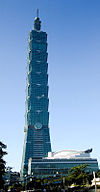
Currency Banking and Finance Taiwan Stock Exchange • Taiwan Futures Exchange • Taiwan Capitalization Weighted Stock Index • CSI Cross-Straits 500 IndexGovernment agencies Fair Trade Commission • Financial Supervisory Commission • Consumer Protection Commission • Taiwan External Trade Development Council • Central Mint of China • China Engraving and Printing WorksResearch Energy Rankings International rankings of Republic of China (Taiwan)Industrial park Associations Agreements Economic Cooperation Framework AgreementCurrencies of China Overview Ancient and medieval Near modern Republic of China Renminbi series Special administrative regions See also: Economy of the People's Republic of China
Economy of TaiwanCurrencies of Asia Central East Chinese yuan · Hong Kong dollar · Japanese yen · North Korean won · South Korean won · Macanese pataca · Mongolian tögrög · New Taiwan dollarNorth South Southeast West Abkhazian apsar (unrecognized) · Afghan afghani · Armenian dram (Nagorno-Karabakh) · Azerbaijani manat · Bahraini dinar · Egyptian pound (Gaza Strip) · Euro (Cyprus) · Georgian lari · Iranian rial · Iraqi dinar · Israeli new shekel (Palestinian territories) · Jordanian dinar (West Bank) · Kuwaiti dinar · Lebanese pound · Nagorno-Karabakh dram (unrecognized) · Omani rial · Russian ruble (Abkhazia, South Ossetia) · Qatari riyal · Saudi riyal · Syrian pound · Turkish lira (Northern Cyprus) · UAE dirham · Yemeni rial Republic of China (Taiwan) topics
Republic of China (Taiwan) topicsSociety Administration Culture Aborigines · Cinema · Communications · Cuisine · Holidays · Literature · Media · Music · Night markets · Sports · Tea · TourismEconomy Geography History History of Taiwan · Taiwan after World War II · Years in the Republic of China · Timeline of Republic of China history · Timeline of Taiwanese historyCategories:- Dollar
- Currencies of Asia
- Circulating currencies
- Economy of Taiwan
- Taiwan under Republic of China rule
Wikimedia Foundation. 2010.
